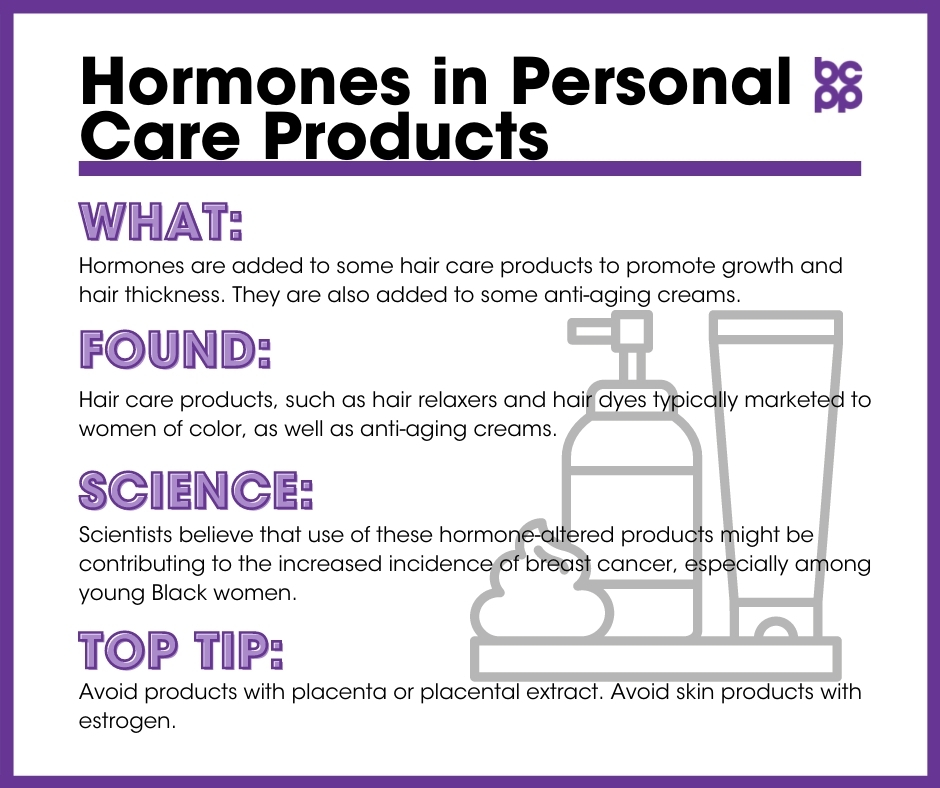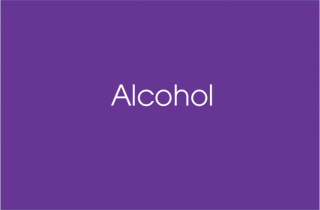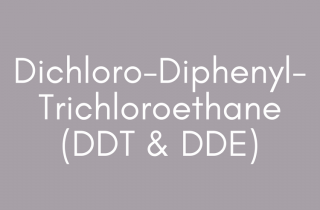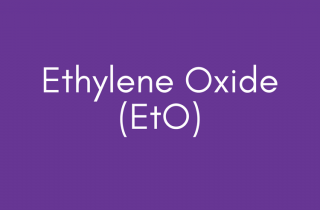Hormones in Personal Care Products
At a Glance
Hair care products, such as hair relaxers and hair dyes marketed to women of color, sometimes include placental extracts, which are likely to contain natural progesterone and estrogens. Estrogen may be added to some anti-aging creams for their effectiveness in raising collagen count and increasing skin hydration.
Hormones in personal care products are listed as a known carcinogen by the International Agency for Research on Cancer (IARC) and the National Toxicology Program (NTP).
What are hormones in personal care products and where are they found?
Hormones such as placental extracts, probably with high concentrations of progesterone[1] and estrogenic chemicals,[2] are sometimes used in cosmetics and hair care products, particularly products marketed to women of color. The addition of hormones and extracts is advertised to promote growth and thickness of hair.
Hormones, especially estrogens, are also added to anti-aging creams[3] because of their effectiveness in raising collagen count and promoting skin hydration. Together, these two factors are thought to decrease wrinkling of the skin,[4] but they can also increase women’s total lifetime exposure to estrogen. Increased exposure to estrogen has been linked to the development of breast cancer later in life by causing rapid cell division of mammary tumor cells when they are present.[5],[6]
What evidence links hormones in personal care products to breast cancer?
- Research indicates that use of products with hormones, such as some hair products, on infants and children may be linked to early puberty or early sexual maturation,[7],[8],[9] which may increase the risk for breast cancer later in life.[10]
- Scientists have proposed that use of these hormone-altered products might be contributing to the increased incidence of breast cancer, especially among young African American women who use these products more than their white counterparts.[11], [12]
- It has been found that extracts from skin and hair products commonly used by African American women had effects on the rapid increase of certain breast cancer cells (MCF-7) in culture; some were estrogenic, while others showed anti-estrogenic activity.[13]
Who is most likely to be exposed to hormones in personal care products?
Any user of hair products containing placenta (and therefore natural hormones); these are more likely to be marketed to women of color.
Who is most vulnerable to the health effects of hormones in personal care products?
Studies have shown infants and children exposed to hormones in personal care products may be more vulnerable to the health effects of these chemicals. Also, young African American women using personal care products with hormones could be at a higher risk for adverse health effects.
What are the top tips to avoid exposure?
- Avoid products with placenta or placental extract.
- Avoid skin products with estrogen.
Reviewed 2019
[2] Tiwary, C M. “Premature sexual development in children following the use of estrogen- or placenta-containing hair products.” Clinical Pediatrics 37, 12 (1998): 733-9. doi:10.1177/000992289803701204.
[3] Olson, Adrienne C et al. “Breast cancer patients unknowingly dosing themselves with estrogen by using topical moisturizers.” Journal of Clinical Oncology 27, 26 (2009): e103-4. doi:10.1200/JCO.2009.23.1225.
[4] Draelos, Zoe Diana. “Topical and oral estrogens revisited for antiaging purposes.” Fertility and Sterility 84, 2 (2005): 291-2; discussion 295. doi:10.1016/j.fertnstert.2005.03.033.
[5] Doisneau-Sixou, S F et al. “Estrogen and antiestrogen regulation of cell cycle progression in breast cancer cells.” Endocrine-Related Cancer 10, 2 (2003): 179-86. doi:10.1677/erc.0.0100179.
[6] Moral, Raquel et al. “Effect of prenatal exposure to the endocrine disruptor bisphenol A on mammary gland morphology and gene expression signature.” The Journal of Endocrinology 196, 1 (2008): 101-12. doi:10.1677/JOE-07-0056.
[7] Tiwary, C M. “Premature sexual development in children following the use of estrogen- or placenta-containing hair products.” Clinical Pediatrics 37, 12 (1998): 733-9. doi:10.1177/000992289803701204.
[8] Li ST et al. “Hormone-Containing Hair Product Use in Prepubertal Children.” Archives of Pediatrics and Adolescent Medicine 156,1 (2002): 85–86. doi:10.1001/archpedi.156.1.85.
[9] Tiwary, Chandra M, and John A Ward. “Use of hair products containing hormone or placenta by US military personnel.” Journal of Pediatric Endocrinology & Metabolism 16, 7 (2003): 1025-32. doi:10.1515/jpem.2003.16.7.1025.
[10] Hsieh, C C et al. “Age at menarche, age at menopause, height and obesity as risk factors for breast cancer: associations and interactions in an international case-control study.” International Journal of Cancer 46, 5 (1990): 796-800. doi:10.1002/ijc.2910460508.
[11] Donovan, Maryann et al. “Personal care products that contain estrogens or xenoestrogens may increase breast cancer risk.” Medical Hypotheses 68, 4 (2007): 756-66. doi:10.1016/j.mehy.2006.09.039.
[12] James-Todd, Tamarra et al. “Racial/ethnic differences in hormonally-active hair product use: a plausible risk factor for health disparities.” Journal of Immigrant and Minority Health 14, 3 (2012): 506-11. doi:10.1007/s10903-011-9482-5.
[13] Myers, Sharon L et al. “Estrogenic and anti-estrogenic activity of off-the-shelf hair and skin care products.” Journal of Exposure Science and Environmental Epidemiology 25, 3 (2015): 271-7. doi:10.1038/jes.2014.32.






